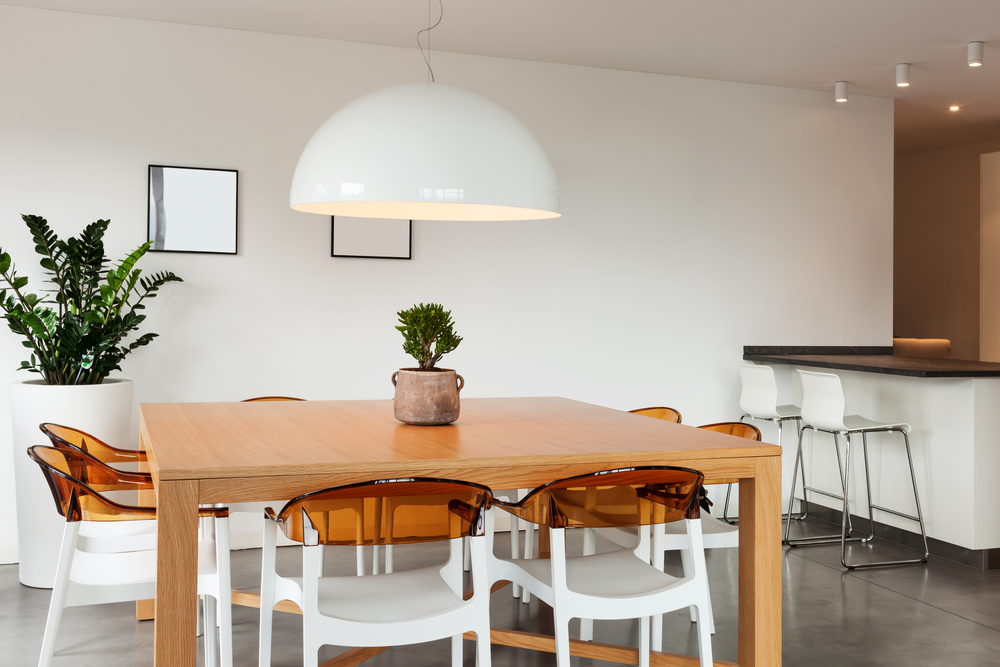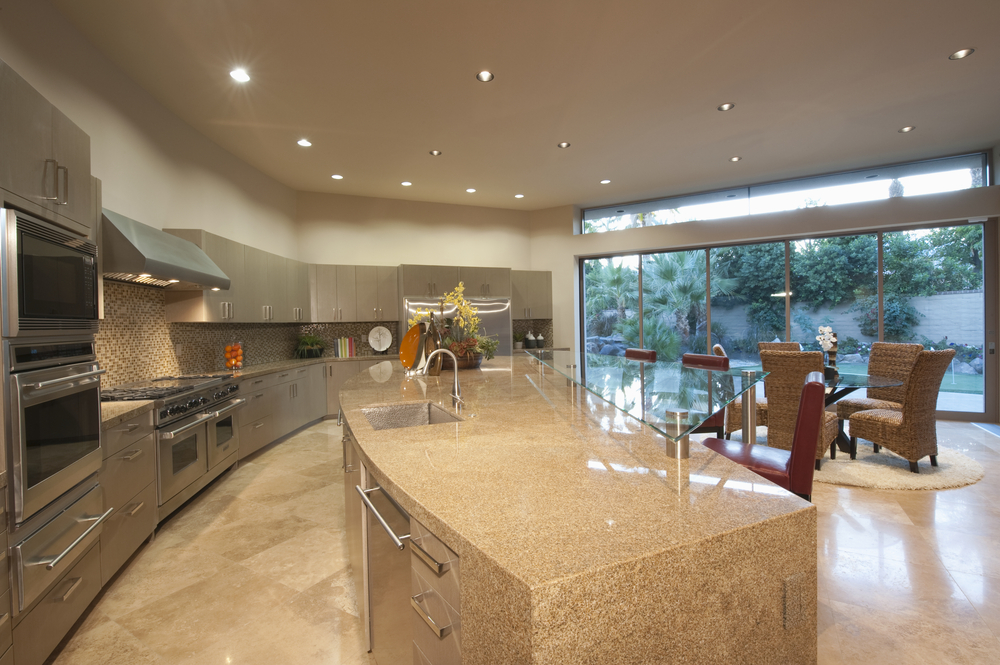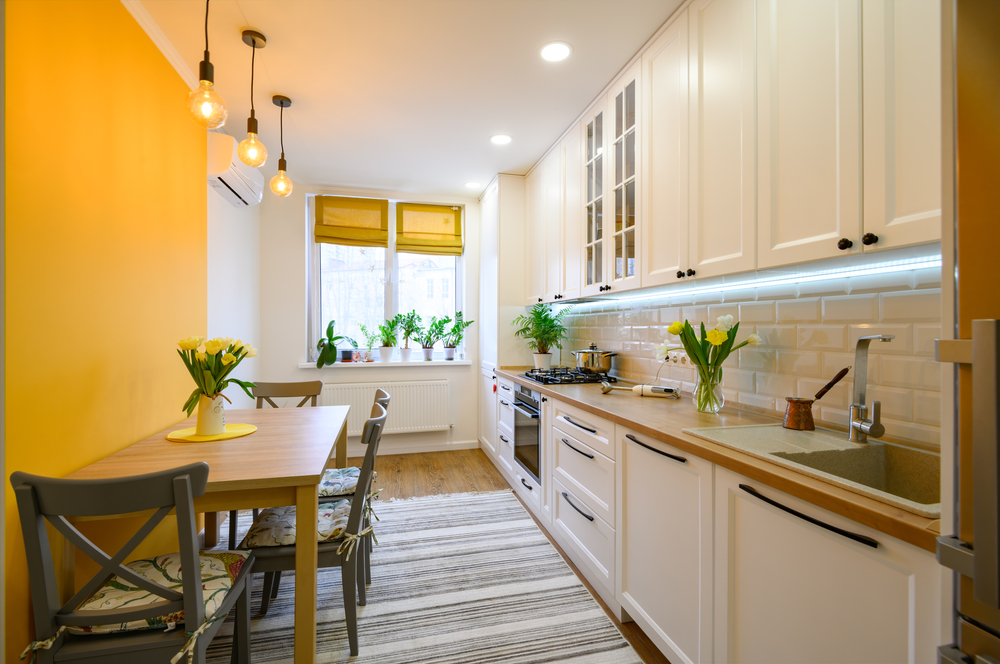Dining room lighting is a vital part of any home. It can set the mood for a meal, provide task lighting for specific activities, or add ambience to the room. There are many different types of dining room lighting fixtures available on the market, so choosing one that fits your needs and preferences is essential.
Dining can be a group or solo activity, and the dining room can change dramatically, depending on the owners’ space usage. Using the examples below, we will cover some popular dining room lighting ideas to help you make the best decision for your home.
Task lighting over the dining table

One of the most important functions of dining room lighting is to provide task lighting for a specific activity, typically being able to see your food clearly while eating at the table. Whatever dining table lighting ideas you choose, you want to get the best light on the table surface with task lights. Recessed lights or pendant lights typically provide this type of light. In this case, a single domed pendant hangs centrally over a large square table, providing even lighting for everyone seated, regardless of position.
Ambient lighting can provide a bright overall light level
In addition to providing task lighting, dining room lighting should also provide ambient lighting. Ambient light is general lighting that helps lift illumination levels in the room. It can be supplied by fixtures such as chandeliers or ceiling lights.
Chandeliers are a classy pendant light option
Chandeliers are a type of lighting fixture hung from the ceiling, i.e. pendant lighting. They typically have multiple light bulbs and can provide a lot of light to the room. Chandeliers come in various styles, both modern and traditional, and in many materials, so finding one that fits the overall aesthetic of your dining room is essential. Lighting over the dining room table tends to be quite central to the space overall and thus a focal point.
A retro light shade ties the room together
Light shades can make or break a room. They should be chosen carefully to complement the style of the room and the fixtures being used. This modern take on a retro light shade ties in with the overall modern aesthetic of the room while still providing good lighting. When thinking about lighting for a dining room, consider the light shades used and the fixtures themselves.
Recessed lighting can provide even illumination in the largest of rooms

Recessed lights are a type of lighting fixture installed into the ceiling. They typically provide a focused beam of light that can be directed at a specific task area, but when used evenly across a room, such as in this example, they can provide even ambient illumination or task lighting, as required.
Multiple pendant lights look classy while serving a purpose
Pendant lights can be a great option if you want to add a touch of style to your dining room. They can be hung at different heights to create an interesting look or use symmetry and matching styles to bring a classy finish to a dining space. In addition, they provide great task lighting, as they hang lower to the surface they are meant to illuminate than recessed ceiling lights.
Simple and adjustable pendant lighting option
This simple domed pendant light can be raised or lowered directly over the dining table, providing the perfect level of task lighting for every occasion. The simple aesthetic matches this small eating area’s clean cream and wood design. It’s always worth considering the intention of the space before picking the lighting scheme. In this case, the small apartment space only needs two people dining space, so a simple lighting option suits the room best.
Combine wall sconces with pendant lighting for an intimate feel
Despite being designed to seat 8 diners, this dining room achieves an intimate feel thanks to its dark walls cutting into the limited available light. In contrast, the low-hanging chandelier and wall sconces provide small pools of illumination, creating an intimate, private dining experience.
Pendant lighting can help reduce the scale of high ceilings

High ceilings are great, but they create the opposite feel to the private, intimate space created in the previous image. While the owner of this property has embraced the size of the space with their use of simple furniture choices, the trio of pendant lighting help to reduce the size of the room and break the feeling of being in a warehouse. Note that the pendant lighting is not used as task lighting over the table but instead to provide ambient lighting to the entire space.
Kitchen-Diner using most lighting types available
This ample space looks warm and inviting, thanks to the use of dark woods surrounded by bright white and light stone colours. A bank of pendant lights provides task lighting over the table, while more hang over the kitchen island. Under-counter illumination highlights the kitchen surfaces, while a grid of downlights brings even ambient lighting throughout the room.
With so many different lighting options available, it can be tricky to know where to start when it comes to choosing the perfect scheme for your dining room. However, by considering the size of the space, the intended mood and the type of light you need, you can narrow down your options and find the perfect solution for your home.
Playful use of colour in dining areas
In the past, dining room LED lighting restrained itself to cool or warm variants of white. However, as people are increasingly engaging with smart home lighting, being able to call down an array of colour options to set the mood for dinner is great fun. This image shows a playful use of light, with the different colours providing an ambient wash over the room and some contrasting task lighting over the kitchen counters.
Indirect lighting using LED light strips
Do you get indirect or direct light when you turn on the dining room light? In this example, the owner has designed the room to be lit with numerous LED strips that emit light from behind panels. This results in a soft, diffuse light that fills the room and creates an inviting glow. The light source is somewhat hidden, giving the space a more luxurious, almost hotel-like, feel.
In addition, LED lights are available in various colours or evening in changeable colour strips so that you can set the perfect mood for any occasion.
Huge space with limited lighting
This huge kitchen and dining room have been designed to use light only where it is needed. This villa is likely to be sun-drenched for most of the day, so lighting will generally only be required in the evening or at night. Directly above the dining table is a recessed panel with warm LED strip lighting all the way around, matching the shape of the dining table below. At the same time, in the distance, pendant lights descend to illuminate the kitchen island and breakfast bar.
Making the best of small spaces

In this narrow kitchen-diner, the owner has designed the space with two purposes in mind and has used lighting accordingly. On the kitchen side, downlights in the ceiling provide plenty of ambient light, while the LED strips under the cabinets provide even task lighting along the length of the counter. On the opposite side of the room, three pendant lights hang directly over the dining table, providing perfect dinner lighting. Notice how the bulb’s colour ties in with the wall, flowers and blinds.
Pendant lights are best over dining room tables
Although there are no hard and fast rules, pendant lights are often considered the best option for lighting over dining room tables. They provide a direct light source, which is perfect for dinner parties or family meals, and they can be easily dimmed to create the perfect mood. This image shows a simple but effective scheme, with three white pendants hanging evenly over the length of the table.
The dining room light is often the most decorative in the house
The dining room is often seen as the heart of the home, so it’s no surprise that the lighting in this room is often the most decorative. There is a real opportunity to enjoy playing with different styles and making a real statement. This image shows a beautiful chandelier hanging over the dining table, with smaller spotlights dotted around the room to provide ambient lighting.
In a simple room, a statement piece makes a dining room extra fancy
As we said above, the dining room is excellent for experimenting with different lighting styles. The previous image showed an intriguing, delicate light fitting. However, in this dining room light fitting, the hanging fitting (Is it a chandelier or just a pendant? Who can tell!) uses LED lighting to great effect. By effectively dropping light onto the table while being visually impressive, it becomes a major talking point for anyone who enters the room.
Splitting a room with different lighting styles
In another great example of a room with split usage, the kitchen area once again features a grid of six downlights, with one other downlight over the short strip that acts as a hallway between the room in the distance, the kitchen, and the dining area. Over the dining table is a more rustic style pendant with a trio of bulbs, which works well over the circular table.
Going large with an enormous chandelier
Sadly, we aren’t lucky enough to have this space to play with. But if you do have a room with a vastly high ceiling and a minimalist mentality to room furniture, you can turn a large chandelier into a feature that draws the eye. In addition, it also helps connect high or vaulted ceilings to the space below. In other words, going large helps shrink the feel of the room.
Natural light can play a part in dining room plans
If your dining room has a lot of windows, you can take advantage of natural lighting. During the day, open the curtains or blinds to let in as much light as possible. You can also use reflective surfaces, such as mirrors, to help bounce light around the room. Plan your lighting set up for the evenings and dark winter days. In this example, when darkness draws in, an elegant chandelier sits up high (which prevents the room from starting to feel small, in the reverse of the previous image) while recessed downlights surround the dining area for plenty of ambient lighting.
Wall sconces work well with downlights
If you’re looking to style dining room lighting without resorting to a pendant above the table, wall sconces can help provide a very pleasing look. Here, two sconces flank the mirror on the wall, with recessed downlights providing ambient lighting in the room. This set-up would work well along a single wall or surrounding the room on all four walls. Wall sconces can be found in various styles, so you should be able to find one that fits your dining room’s decor.
An industrial light breaks up a clean, minimalist look
In this ultra minimalistic white-dominated space, the primary lighting over the eating/preparation area comes from an off-centre industrial effect light. The apparent randomness of the light elements juxtaposes against the clear, hard edges of the other elements in the room. This look is supplemented by directional spotlights in the ceiling pointing down at the eating area.
Conclusion
When it comes to designing the lighting for your dining room, remember that there is no right or wrong. The dining room is a personal space within your home that should reflect some part of your personality. However, there are a few things to keep in mind. Consider the different types of lighting and what each one can provide. Are you looking for clean, bright dining room lights or something more romantic? Are you drawn to large visual objects, like chandeliers, or more industrial looks, made of black steel and sheet glass?
We hope that we’ve been able to provide you with some good dining room lighting ideas. With our tips and suggestions in mind, you should be able to create the perfect dining room lighting scheme for your home. Good luck!
We typically recommend that the best lighting for dining rooms is a centralised light over the dining table, with plenty of ambient light to bring up the levels in the rest of the room. But it will depend on your style and your plans for the room. If you want the room to feel more romantic, place a pool of light over the table and allow the rest of the room to be at a much lower ambience. In contrast, a busy, functional space might need a bright overall ambience without fussing too much with light over the table.
There are many options to light a room without using a chandelier. For example, dining room down lighting is widespread, giving an even ambience to the room. You can also opt for wall sconces, LED lighting strips, pendants, or a mix of all of these. If you have large windows, you may find yourself able to enjoy natural light through most meals of the day.
The best lighting for a dining room is light that suits the space. The same is true for the light directly over the table. The light should suit the style of the room and be in keeping with any other lights you have chosen. If you want a very grand look, go for a large, dramatic chandelier. If you prefer something more subtle, try a simple pendant with shade, or even look at recent designs that blend modern style with retro bulbs for a chic result.
There’s no rule to say that it should, but the most pleasing look is often achieved when the main light of your dining area is centred over the table. It helps to create an intimate feel and can also be more practical, as you’re more likely to get even light distribution over your eating area. However, it’s not essential, and if your room is long or narrow, you may prefer to have the light off-centre so that it extends further down the table, or even be central to the room and ignore the table. There is no right or wrong to home design, just ideas that you like.
Leave a Reply